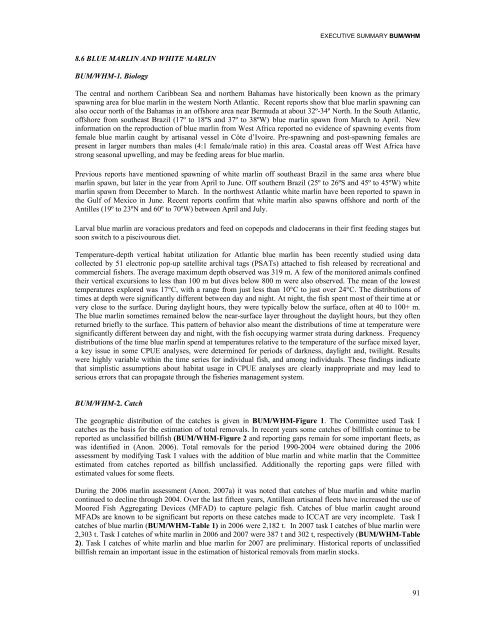REPORT OF THE STANDING COMMITTEE ON RESEARCH ... - Iccat
REPORT OF THE STANDING COMMITTEE ON RESEARCH ... - Iccat
REPORT OF THE STANDING COMMITTEE ON RESEARCH ... - Iccat
Create successful ePaper yourself
Turn your PDF publications into a flip-book with our unique Google optimized e-Paper software.
EXECUTIVE SUMMARY BUM/WHM8.6 BLUE MARLIN AND WHITE MARLINBUM/WHM-1. BiologyThe central and northern Caribbean Sea and northern Bahamas have historically been known as the primaryspawning area for blue marlin in the western North Atlantic. Recent reports show that blue marlin spawning canalso occur north of the Bahamas in an offshore area near Bermuda at about 32º-34º North. In the South Atlantic,offshore from southeast Brazil (17º to 18ºS and 37º to 38ºW) blue marlin spawn from March to April. Newinformation on the reproduction of blue marlin from West Africa reported no evidence of spawning events fromfemale blue marlin caught by artisanal vessel in Côte d’Ivoire. Pre-spawning and post-spawning females arepresent in larger numbers than males (4:1 female/male ratio) in this area. Coastal areas off West Africa havestrong seasonal upwelling, and may be feeding areas for blue marlin.Previous reports have mentioned spawning of white marlin off southeast Brazil in the same area where bluemarlin spawn, but later in the year from April to June. Off southern Brazil (25º to 26ºS and 45º to 45ºW) whitemarlin spawn from December to March. In the northwest Atlantic white marlin have been reported to spawn inthe Gulf of Mexico in June. Recent reports confirm that white marlin also spawns offshore and north of theAntilles (19º to 23ºN and 60º to 70ºW) between April and July.Larval blue marlin are voracious predators and feed on copepods and cladocerans in their first feeding stages butsoon switch to a piscivourous diet.Temperature-depth vertical habitat utilization for Atlantic blue marlin has been recently studied using datacollected by 51 electronic pop-up satellite archival tags (PSATs) attached to fish released by recreational andcommercial fishers. The average maximum depth observed was 319 m. A few of the monitored animals confinedtheir vertical excursions to less than 100 m but dives below 800 m were also observed. The mean of the lowesttemperatures explored was 17°C, with a range from just less than 10°C to just over 24°C. The distributions oftimes at depth were significantly different between day and night. At night, the fish spent most of their time at orvery close to the surface. During daylight hours, they were typically below the surface, often at 40 to 100+ m.The blue marlin sometimes remained below the near-surface layer throughout the daylight hours, but they oftenreturned briefly to the surface. This pattern of behavior also meant the distributions of time at temperature weresignificantly different between day and night, with the fish occupying warmer strata during darkness. Frequencydistributions of the time blue marlin spend at temperatures relative to the temperature of the surface mixed layer,a key issue in some CPUE analyses, were determined for periods of darkness, daylight and, twilight. Resultswere highly variable within the time series for individual fish, and among individuals. These findings indicatethat simplistic assumptions about habitat usage in CPUE analyses are clearly inappropriate and may lead toserious errors that can propagate through the fisheries management system.BUM/WHM-2. CatchThe geographic distribution of the catches is given in BUM/WHM-Figure 1. The Committee used Task Icatches as the basis for the estimation of total removals. In recent years some catches of billfish continue to bereported as unclassified billfish (BUM/WHM-Figure 2 and reporting gaps remain for some important fleets, aswas identified in (Anon. 2006). Total removals for the period 1990-2004 were obtained during the 2006assessment by modifying Task I values with the addition of blue marlin and white marlin that the Committeeestimated from catches reported as billfish unclassified. Additionally the reporting gaps were filled withestimated values for some fleets.During the 2006 marlin assessment (Anon. 2007a) it was noted that catches of blue marlin and white marlincontinued to decline through 2004. Over the last fifteen years, Antillean artisanal fleets have increased the use ofMoored Fish Aggregating Devices (MFAD) to capture pelagic fish. Catches of blue marlin caught aroundMFADs are known to be significant but reports on these catches made to ICCAT are very incomplete. Task Icatches of blue marlin (BUM/WHM-Table 1) in 2006 were 2,182 t. In 2007 task I catches of blue marlin were2,303 t. Task I catches of white marlin in 2006 and 2007 were 387 t and 302 t, respectively (BUM/WHM-Table2). Task I catches of white marlin and blue marlin for 2007 are preliminary. Historical reports of unclassifiedbillfish remain an important issue in the estimation of historical removals from marlin stocks.91
















